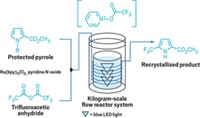Advertisement
Grab your lab coat. Let's get started
Welcome!
Welcome!
Create an account below to get 6 C&EN articles per month, receive newsletters and more - all free.
It seems this is your first time logging in online. Please enter the following information to continue.
As an ACS member you automatically get access to this site. All we need is few more details to create your reading experience.
Not you? Sign in with a different account.
Not you? Sign in with a different account.
ERROR 1
ERROR 1
ERROR 2
ERROR 2
ERROR 2
ERROR 2
ERROR 2
Password and Confirm password must match.
If you have an ACS member number, please enter it here so we can link this account to your membership. (optional)
ERROR 2
ACS values your privacy. By submitting your information, you are gaining access to C&EN and subscribing to our weekly newsletter. We use the information you provide to make your reading experience better, and we will never sell your data to third party members.
Synthesis
Green Cross-Couplings Via Electrosynthesis
Electrochemical method sparks a simple and efficient cross-coupling of phenols to make nonsymmetrical biaryl diols
by Stephen K. Ritter
April 7, 2014
| A version of this story appeared in
Volume 92, Issue 14
By using organic electrosynthesis, a research team in Germany has developed a one-step protocol for cross-coupling phenols to make nonsymmetrical biaryl diols, which are useful in natural product synthesis, in materials science, and as catalyst ligands (Angew. Chem. Int. Ed. 2014, DOI: 10.1002/anie.201400627). In the green method, the team led by Siegfried R. Waldvogel of Johannes Gutenberg University, and including researchers at specialty chemical company Evonik Industries, takes advantage of electric current as a highly selective oxidizing agent. Leaving groups, protecting groups, and a catalyst often needed in cross-coupling reactions aren’t required, they note, thereby streamlining the process while avoiding hazardous reagents, generating less waste, and reducing cost. “The process uses a very simple setup, readily available electrodes, mild reaction conditions, and a recyclable solvent system,” notes R. Daniel Little, an electrosynthesis expert at the University of California, Santa Barbara. The researchers use a traditional power supply, Little adds, but a simple sunlight-driven photovoltaic power supply should suffice and help minimize scale-up cost for commercialization. Waldvogel and his colleagues suggest the chemistry could also be accomplished using a microflow reactor, which would further increase efficiency and reduce waste.





Join the conversation
Contact the reporter
Submit a Letter to the Editor for publication
Engage with us on Twitter